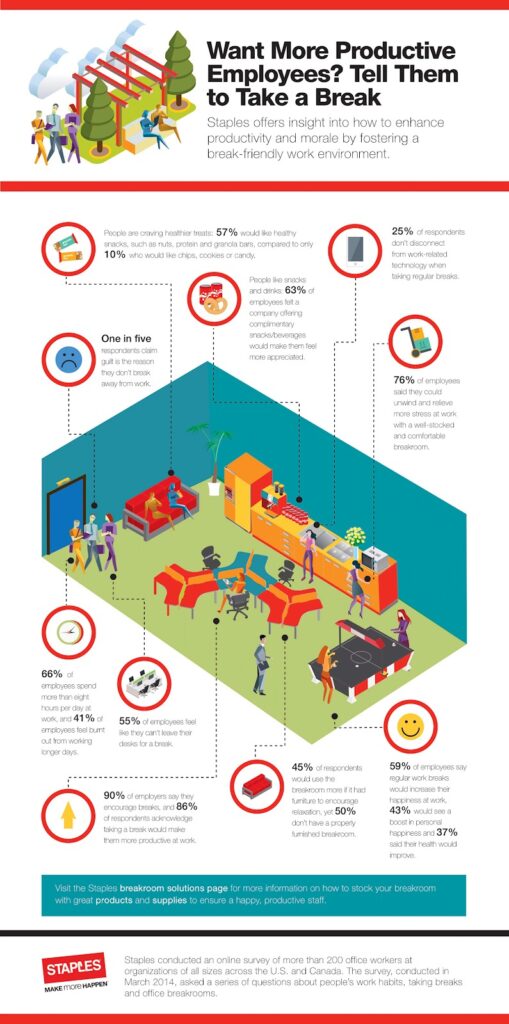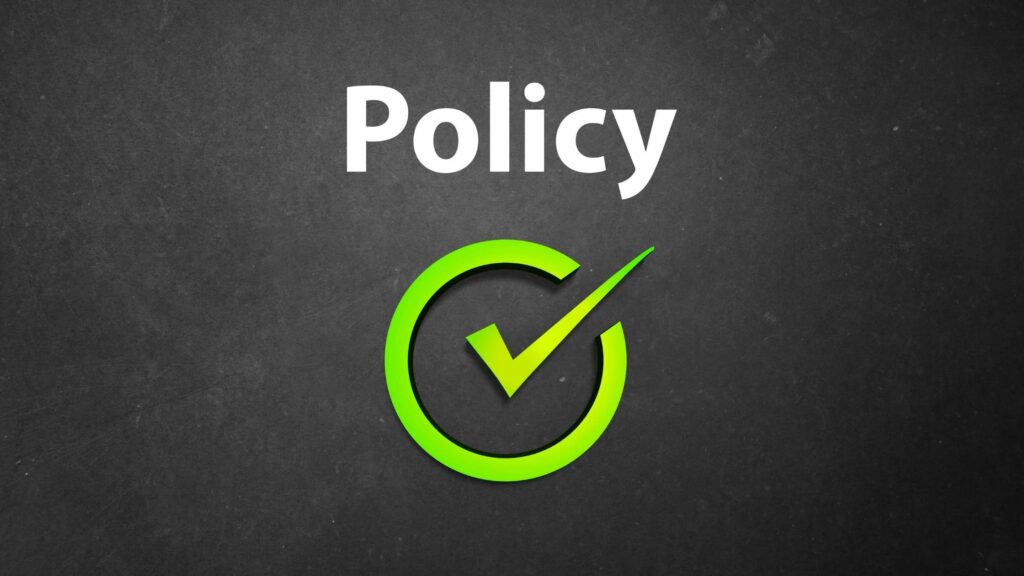Employees today constantly strive to perform better in the workplace. They take on extra projects, work relentlessly without breaks, and barely move from their desk. However, being holed up in your cabin or skipping your lunch isn’t the key to professional success.
In fact, this mentality is rather ineffective and definitely unhealthy. And as an employer, it is your responsibility to offer proper breaks to all your employees. Regular employee breaks improve the morale and efficiency of the workplace.
In 2014, Staples conducted an inclusive study on employee breaks. The survey showed that 86 percent of employees agreed that taking a break would make them more productive. These breaks also tend to raise the morale of employees by 59%.

There is no question that providing breaks has its benefits to the overall well-being of your employees. But before you formulate a policy for employee breaks, you need to understand the rules.
Legal breaks at work
How long should they be?
During an eight-hour work shift, an employee should get a 30-minutes break with two additional 15-minute intervals. Shifts consisting of more work hours must include more breaks.
How often should you offer breaks?
Doing repetitive activities or staying in one place for too long will take a toll on not only the body but also the attention span. Mistakes can easily be induced by mental or physical exhaustion, whether sitting on a computer or operating a machine. In certain work environments, lack of concentration or emphasis is a significant safety threat.
MIT Sloan Senior Lecturer Bob Pozen, author of the book Extreme Productivity: Boost Your Results, Reduce Your Hours, suggests taking a break every 75-90 minutes. In addition, Tony Schwartz, in his research, shows that naturally, we move from full focus and energy to fatigue every 90 minutes.
There is an explanation behind the repetitive job breaks. The human brain has two modes. One is learning/focusing, and the other is consolidation. Taking regular job breaks allows the brain to recognize and recall information that has recently been processed.
Some studies by The Energy Project shows that people spontaneously go from full-focus to physiological exhaustion almost every 90 minutes.
Rest breaks
The rest breaks normally take between 5 to 20 minutes. Ideally, you should include rest breaks in the total time an employee works. If these breaks force an employee to work overtime, you should pay the employee overtime wages.
The Fair Labor Standards Act (FLSA), which protects the rights of the employees, defines rest breaks. Although FLSA sets the rest breaks rules, federal law doesn’t force you to provide your employees with rest breaks.
Laws on rest breaks
Very few cities mandate employers to allow taking breaks for rest during the working hours. Most of these states offer that workers can have a ten-minute rest with compensation every four working hours. Several jurisdictions consider workers to choose between meal or rest breaks. These require employers to provide employees with enough time to take bathroom breaks.
Meal breaks
Meal breaks are normally 30 minutes or longer. You don’t have to pay for these breaks. You also don’t have to include meal breaks in the overall work hours of the employee.
There’s a catch when it comes to lunch breaks. If an employee does some sort of work during a meal break, you have to pay the employee in that case. The break would also count towards the cumulative time the employee works. Even when the employee does anything as simple as answering calls or emails, you should compensate for that, too.
The FLSA also sets out rules for meal breaks. Once again, federal legislation does not require you to give a meal break.
Laws on meal breaks
Many employers are required to provide a meal break for their employees. Usually, a worker who works more than five or six hours at a time requires half an hour to eat. Some states forbid workers from giving this time off at the beginning or at the end of the shift.
Employers are not entitled to pay their employees for the time off if they are absolutely free of all job responsibilities. When an employee has to work during meal breaks—for example, by taking calls or waiting for a shipment, they have the right to charge for that time.
Some other types of breaks

Besides rest and meal breaks, there are several other types of breaks, too, including the following:
1. Smoke breaks
The workers who smoke may require more frequent breaks than usuals. But in order to boost their morale, you can offer them some cigarette breaks. Remember that you are not forced to provide the employees with smoke breaks.
If you do allow smoke breaks, you should be fair to all your staff. Your non-smoking workers may find the smoke breaks unfair because they don’t get any extra breaks. If you give cigarette breaks, you may want to offer extra breaks to non-smokers as well.
If workers take unauthorized breaks to smoke, they are not allowed to pay or count the time to their overall time working.
2. Bathroom breaks
Unlike other types of breaks, you have to make bathroom breaks accessible to workers. The Occupational Safety and Health Administration (OSHA) specifies that workers must have access to toilet facilities. Often, you cannot compel staff to obey a certain timetable for bathroom breaks.
3. Breaks for health hazards
An employee may have a health condition that needs regular breaks. If an employee has a health condition that falls under the disabilities act, you need to provide the employee with “reasonable compromise.” This ensures that you’d have to make changes to accommodate the employee.
For example, the workers who have diabetes need to take extra breaks to eat and check their sugar and insulin levels. You should authorize these workers to take extra breaks to meet their health needs.
4. Breaks for religious purposes
Employees can ask you for extended breaks for religious purposes. They may need additional time for prayers or religious readings.
You can offer suitable accommodations for the employee as long as this does not bring undue inconvenience to you.
You can expect the employee to make up the time taken for breaks in order to practice their faith. Or, you might ask the employee to take advantage of the breaks you’ve already offered.
5. Breaks for nursing mothers
Nursing mothers who are working for you need breaks so that they can express breast milk. You don’t need to pay for the employee in this case. Also, this time, you don’t have to count towards the employee’s hours worked.
6. Breaks for young workers
Several cities encourage employers to provide young employees with meal or rest breaks. In regions requiring breaks for adult staff, the laws for minors are also tighter.
There are some special break rules for all minors in some states, especially for employees who are not even 18 years old. In contrast, others have special laws on breaks only for juveniles who are 15 years of age or younger.
Why do we need to create employee breaks policies?
Employee breaks for more productivity
After working rigorously, one needs a break to feel recharged. Some advantages of frequent work breaks are as follows:
- Workplace fatalities and injuries attributable to lack of care are minimized
- Work performance increases dramatically, resulting in a rise in gross income.
- Employee morale rises significantly.
Taking time away from work increases productivity. A short amount of time away from work offers workers the opportunity to stretch sore muscles, find relief from sustained stresses and postures, and absorb any insight they may have gained in the last few hours or so.
Better job satisfaction
Usually, it is seen that employees who take frequent breaks between their working hours have comparatively more satisfaction than most other workers. It increases workplace motivation, energy, and concentration. Employees relieve work stress and experience less somatic symptoms like headaches and body pain when they take breaks.
Better mental health
Stress is shockingly prevalent in the workplace and has adverse effects on workers. Taking some time away from work to go for a short walk or enjoy a nutritious lunch helps alleviate some of this tension and increases mental well-being. Most of the North American workers agree that they feel refreshed and energized after having a break for lunch.
Helps boost creativity
To allow your brain to function at its full potential, you need to take breaks while working. Not only does this boost your productivity, but it also boosts your creativity and innovation power. You get enough time to incubate your ideas.
Naturally, our imagination tends to shut down at times, causing a “mental block”. This causes more problems in thinking differently and innovating ideas. Taking time away from the desk allows you to step back a little. Thus, you can clear your mind and picture things creatively.
Helps you avoid burnout
Not only is it important to take breaks to give your mind time to produce new ideas, but it is also crucial to help you overcome burnout.
When working from home during the ongoing pandemic, workers can feel an increased burden to work overtime or to avoid taking breaks in order to prove that they are working efficiently. This is where trust in your workers becomes crucial. If you believe your workers to do a good job and meet their commitments, you will inspire your staff to build a much healthier working atmosphere when at home. Clarify to the team that it’s all right, and it’s also appreciated to take some time away.
Under usual working conditions, one will naturally get up from the table to have a coffee or pause for a short talk with a coworker. When you’re working from home, it can be easy to halt all these breaks, thus making it more important that you move away from the computer. Even if you stretch your legs for 5 minutes around the house, taking these slight step-backs intermittently during the day can help you stay focused and raise your energy level up.
Encourages healthier habits
You are likely to experience stress if you don’t take breaks. If this stress is not treated, it can become severely detrimental to your health over time. Taking breaks helps in maintaining a balanced lifestyle in all facets of your life, such as taking time for regular meals, exercises, and regular sleep. Once your mind is free from constant feelings of mental stress and pressure, you are more likely to be in a better place to make healthier decisions in life. Over time, these lifestyle decisions can help improve your productivity and enthusiasm so that you can come up with fresh ideas and innovative solutions.
Now that you know the laws and all the nitty-gritty of employee breaks policy and why it is important to have one, how would actually create one for your company?
Formulating employee breaks policy

After reviewing all the laws, you need to create your policy for employee breaks. This is just to make your workers understand what you will be offering them. The policy must be clear and fair. This will help you to follow the laws of the company. Make sure you abide by the federal and state laws.
Try to address the interests of your employees as well. If it takes more time to reach the nearest restaurant or cafe than the lunch break, it will be impossible for the employees to abide by the rules. Hence, you need to be considerate while developing an employee break policy.
If you struggle to keep track of employee breaks, you can always rely on Time Doctor.
Time Doctor not only tracks the working hours of the employees but also tracks the breaks and the time your employees are spending away from the computer. This will make tracking employee breaks and working hours a seamless experience.
Visit Time Doctor and try it out for FREE for 14 days to find out where your team is spending their time during work and track your employees.

Carlo Borja is the Content Marketing Manager of Time Doctor, a workforce analytics software for distributed teams. He is a remote work advocate, a father and a coffee junkie.


